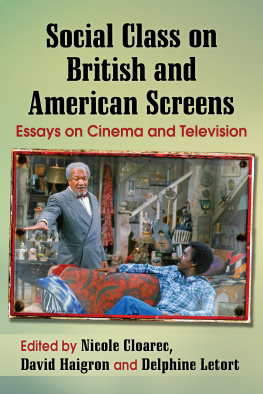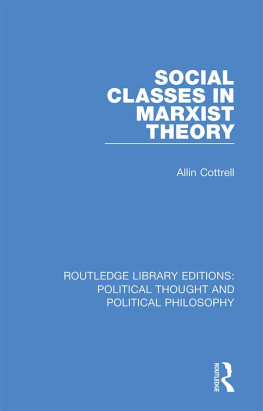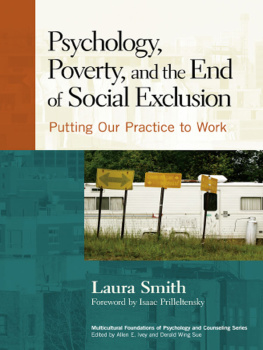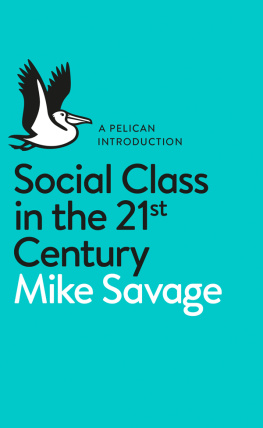
Social Class on British and American Screens
Essays on Cinema and Television
Edited by Nicole Cloarec, David Haigron and Delphine Letort

McFarland & Company, Inc., Publishers
Jefferson, North Carolina
Acknowledgments
We would like to thank all the people and institutions who have contributed to make this volume possible, in particular Rennes 2 University and its research group ACE (EA 1796) which, in partnership with 3L.AM (EA 4335) at the University of Le Mans (Universit du Maine), hosted the conference which inspired most of the essays.
We would also like to thank the research groups LIDILE (Rennes), HCTI (Universit de Bretagne Occidentale), ERIBIA (Caen), ESO (Rennes 2), the SERCIA association, the Institut des Amriques and the Institut franco-amricain for their support.
LIBRARY OF CONGRESS CATALOGUING DATA ARE AVAILABLE
BRITISH LIBRARY CATALOGUING DATA ARE AVAILABLE
e-ISBN: 978-1-4766-2312-2
2016 Nicole Cloarec, David Haigron and Delphine Letort. All rights reserved
No part of this book may be reproduced or transmitted in any form or by any means, electronic or mechanical, including photocopying or recording, or by any information storage and retrieval system, without permission in writing from the publisher.
On the cover: Demond Wilson and Redd Foxx from Sanford and Son, 19721977 (NBC/Photofest)
McFarland & Company, Inc., Publishers
Box 611, Jefferson, North Carolina 28640
www.mcfarlandpub.com
Introduction
Nicole Cloarec
Shortly before becoming prime minister in 1990, John Major famously promised to build a genuinely classless society. Nonetheless, the fact that after a grocers daughter, the Brixton-grown, state-school educated son of a circus performer could become prime minister was nothing but a very inspiring example of upward mobility.
More than 20 years later, in a speech to Tory constituents, John Major declared he found truly shocking that in every single sphere of British influence, the upper echelons of power in 2013 are held overwhelmingly by the privately educated or the affluent middle class. After the advent of David Cameron and Nick Clegg at the head of the government was dubbed the return of the toffs in the media, the perceived collapse in social mobility has been amply commented upon by manyincluding scholars and politicians such as the governments social mobility adviser and former Labour Cabinet member Alan Milburn who declared:
The shocking lack of social mobility is entrenched in British society. There is a glass ceiling in British societyand more and more people are hitting it. Whether it is law or medicine or journalism or politics, the upper echelons of Britain are dominated by a social elite. [] One-third of MPs, half of senior doctors and over two-thirds of high court judges all hail from the private schools that educate just 7% of our countrys children. The data is so stark, the story so consistent, that it has all the hallmarks of social engineering. Sir John Major is right to be shocked.
More surprisingly, similar cries of alarm have recently been sounded across the Atlantic, in a nation which has supposedly built itself by rejecting the rigidity of the British class system in favor of a truly classless society in which the American dream holds the promise of equal opportunities for all to rise socially. In his 2014 state-of-the-union address, President Barack Obama deplored the increasing social inequalities that compromise the American dream
Despite Lady Thatchers endeavor to erase the term from the British political scene, the notion of social class has come back in the national debatewith a vengeance. The large media coverage and popular success of The Great British Class Survey bear witness to the enduring fascination British people have with questions of social distinction. Through that survey, which draws on Pierre Bourdieus notion of cultural capital and examines the respondents cultural and social life as much as their economic standing, a group of sociologists claims to identify a new model composed of seven classes, in his acclaimed book Chavs: The Demonization of the Working Class (2011), which exposes class hatred in modern Britain, raising the nagging question: How did the salt of the earth come to be viewed as the scum of the earth?
If such media coverage might not seem so surprising in Great Britain where class, like the weather and the monarchy, is a peculiarly and particularly British preoccupation,
Ironically, the definition of class itself has increasingly been the subject of much debating among scholars. If until the mid1970s class analysis provided the grandest and most masterly narrative available, Most specifically, cultural perspectives, feminist and postcolonial studies have challenged class as the prevailing category of social analysis, foregrounding instead a conception of identities as decentered and motile, the products of conflicting cultural forces and interpersonal relationships.
What emerges from this ongoing debate is a significant shift from analyzing society through the concept of class to analyzing the very concept of class as a discursive and representational construct determined by historical context and discourse. In other words, the new class paradigms are as much conceptual models constructed to analyze society as the subjects of analysis themselves. becomes critical. Now cinema and television have long proved to be powerful popular media that contribute to building up, strengthening or, on the contrary, challenging collective and stereotypical representations of social groups.
Many recent studies have documented the part that Hollywood and American films in general have played in bolstering and sustaining the American dream. Studies on early American cinema have shown how cinema gained its popularity by appealing primarily to working class audiences in industrial cities and quickly became one of the means for integrating newcomers into the values and customs of their new country. Very soon, though, the film industry, while originally receiving their principal support from the lowest and most invisible classes in American society, Hollywood in particular has long nourished the myth of an open society where the cross class fantasies emphasize class harmony while eschewing any realistic representation of working class living conditions. Images of the middle class have prevailed along with racial and political discourses that contribute to marginalizing other classesbe they the ruling dynasties or the underclass. Likewise, television dramas more often than not mirror the mainstream ideology by extolling the virtues of the middle class, their social aspirations and their conservative values.
In the United Kingdom, portrayals of class and class differences in the media have proved enduringly popular: from the lasting success of television series such as Upstairs, Downstairs (LWT, 197175, updated in 2010 by the BBC) or the multi-award-winning, critically-acclaimed Downton Abbey (ITV, 2010) to the character of Vicky Pollard in Little Britain (BBC, 200306), from the nostalgic indulgence of heritage films to the scathing criticisms of Ken Loachs social realist films, television and cinema have both shaped and challenged stereotypes that articulate the ideological discourse on class.
Caught in the dialectic movement of documenting social realities while also contributing to changing them, films have therefore been battlegrounds for public understandings of labor, capital, and class. But the notion of class not only helps shed a critical light on the content of film representations, it also raises questions of aesthetic strategies and genres. Class therefore proves a useful concept as it raises aesthetic and ideological questions that underpin the analyses of genres, influencing conventions and characterization. The concept of class representation has thus been a major critical tool in a number of academic works about British cinema, John Hill relates the tradition of realist and documentary aesthetics to class:
Next page








